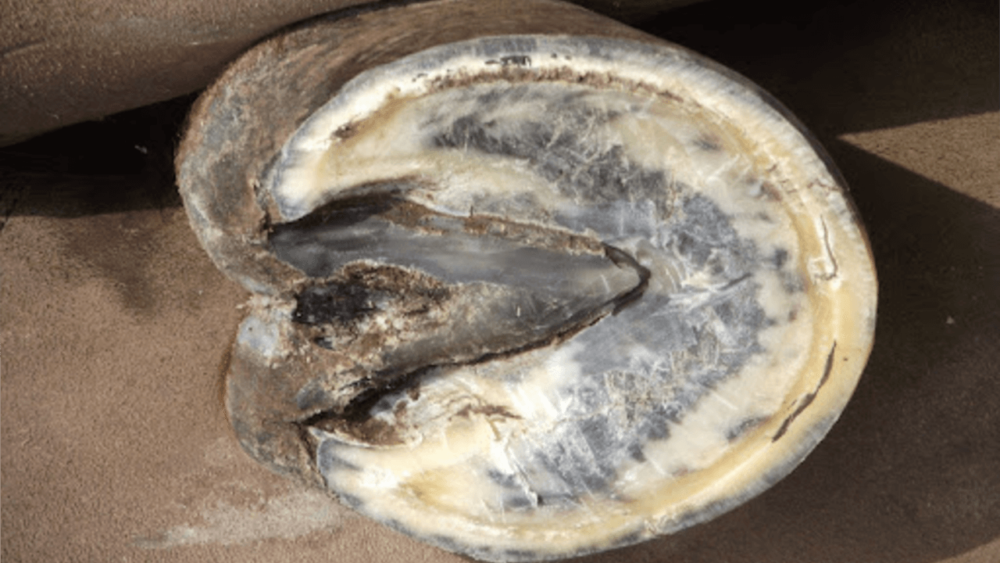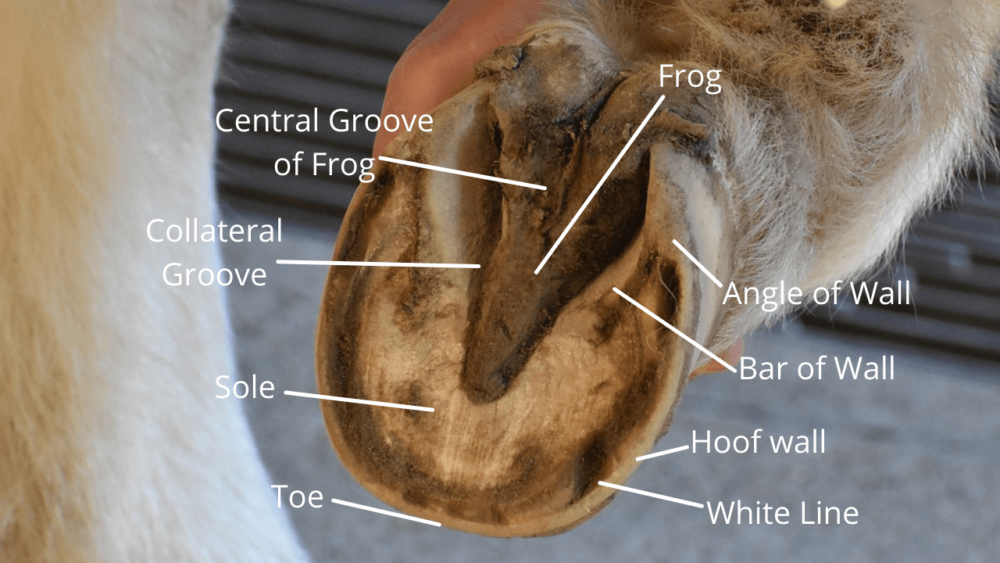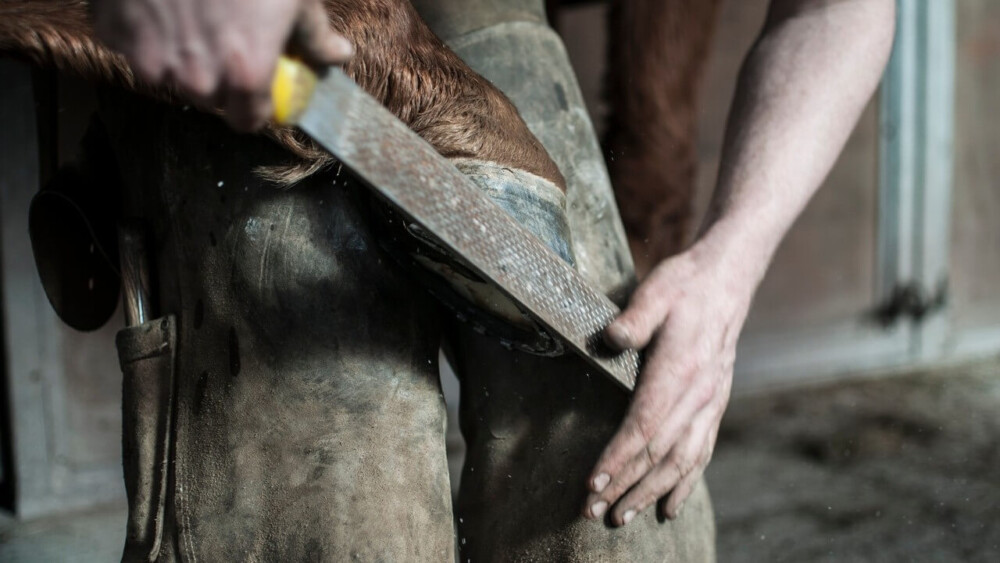There is an old saying among many horse people: No hoof, no horse. This is a timeless truth. A horse with bad hooves that are overgrown or badly worn or whose hooves are cracked will inevitably go lame. If the damage is severe enough, such as a serious degloving of the hoof capsule, you may have to put your horse to sleep.
What is a degloved horse hoof? A degloved hoof is an injury in which the entire outer part of the hoof (hoof wall) detaches from the sole of the hoof. The hof is left without a cap. Degloving is a serious injury.
How do you prevent degloving a hoof? Prevent a degloving hoof by utilizing a good farrier who will be able to help you when your horse needs maintenance on their hooves. Form riding habits to encourage great hoof health. Never delay treating hoof injuries. Make sure you treat hoof-related injuries seriously to prevent infections.
Degloving a hoof can occur if your horse suffers a serious injury or if they have a preexisting condition that could lead to the removal of the hoof capsule.
A degloved hoof can regrow, though it can take over a year for a full recovery. The care process is extensive and long-term, and there are no guarantees whether your horse will be sound again or if it will make a good enough recovery. Horses may still suffer from pain for the rest of their lives. Prevention is better than cure, so let’s look at preventing injuries and illness regarding your horse’s hooves.
Healthy Hoof Care Know-How
Your horse is only as good as their feet. A horse’s hooves are a small percentage of their body, yet those four small feet carry a 1,000-pound plus animal. This means that the surface of their hooves will be under tremendous pressure, and you need to care for your horse’s hooves regularly. Degloving a hoof is one of the most serious injuries a horse can sustain to their hooves.
How do you care for a horse’s hooves? Ensure your horse’s hooves are healthy by checking and daily cleaning for hooves daily. Actively watch for certain signs and act swiftly when you see a problem starting to form. Provide regular care of hooves through a competent Ferrier.
Daily Cleaning: Essentials To Horse Health
Daily cleaning and care for your horse’s hooves include the following routine:
1. The First Visual Inspection
It’s a good idea to inspect your horse’s hooves every day. This will help you quickly spot when there are changes that happen. Your horse’s hooves will change as the seasons change. In the dry season, you may notice some small surface cracks (wind cracks) that appear. These are no cause for concern, but they do indicate the hoof is dry.
A horse’s hoof is like a human fingernail. Their hooves also suffer damage when they are too dry, so you can absolutely apply a moisturizing cream like udder or milking cream, which is rich in vitamin E. This will help nourish your horse’s hooves and prevent the cracks from worsening. The cream also helps your horse’s coronary band (or horse cuticle) from splitting and forming painful dry skin.
In wet seasons, your horse’s coronary band can become wrinkled and bubbly. This indicates the hoof has absorbed too much moisture. It’s similar to how your skin gets wrinkly when you sit in the bath for too long.
If you notice this in your horse, you may want to check their grazing area. Look for a lot of moisture or mud. If you see this, move them to a dryer damp for a few days. Applying milking cream will also help wet hooves as moisture can strip vital oils away from the hoof. If a wet hoof is left untreated and doesn’t dry out, hoof rot can set in.
2. Hoof Picking
Following the visual inspection, use your hoof pick to clean out the horse’s hooves. Familiarize yourself with the parts of the horse’s hoof so you know which parts are sensitive and which are insensitive. The bottom of the horse’s foot, when you lift it, is essentially an upside-down V.
This V is known as the horse’s frog, and it contains sensitive tissue. Around the V, you will see the sole of the horse’s foot, and near the bottom points of the V are the bars of the heels. The outside edge of the hoof is the horse’s nail, and it is this narrow surface that your horse is actually walking on. Amazing, right?
Use your hoof picks sharp end, insert it at the first of the bottom V points. Push it into the narrow “trench” you find there. Push away with the hoof pick to dislodge any stones, mud, or muck that has collected there. Beginners are always amazed at how much stuff can become collected there. If the mud is really compressed, you may need to hose your horse’s hooves to soften the mud. This will allow you to clean their feet more easily.
Repeat this for the other side of the V. There may also be a small amount of debris accumulating on the section between the V-points (on top of the frog). To remove this, you should be more careful as there is soft tissue underneath. You don’t want to sink your hoof pick into your horse’s foot accidentally.
The Graphics team will add an image of the anatomy of the hoof.
3. The Second Visual Inspection
Once you have cleaned the hoof, you should inspect it again. Pay attention to the nail. Is it an even height, or have parts of it broken off? When your horse begins to walk on their soles, it can cause them to develop abscesses, and they can go lame.
Your farrier will be able to balance your horse’s hooves, ensuring there is a maximum weight-bearing surface (in the nail) to carry the horse’s weight effectively.
Another area you should be carefully inspecting is the frog and the V-shaped trench around the frog. This is where thrush may form. When you smell it, you will quickly know if your horse’s feet are in trouble.
A foul smell that is quite pungent will indicate the beginnings of thrush. Black tissue will also be present in the bottom of the hoof trenches, and in some cases, if you squeeze down on the frog, you will see white puss ooze out.
What now?
Having cleaned the hoof, you can take a 6% hydrogen peroxide solution and a syringe (without a needle). Spray this into the hoof trench or collateral groove. You will see a satisfying fizzing happening. This is not painful for your horse, and it is only cleaning out the infected tissues of the frog.
Keep their hoof suspended in the cleaning position for a few moments. Wait until the fizzing has almost stopped, then you can lower it. If you have wound spray (or purple spray as horse people call it), you can spray this onto the area to help keep it sanitized.
4. Lower Leg Cleaning
While you may not see your horse’s lower leg as part of their hoof, it is essential for hoof health. Injuries to the coronary band can create imperfections and scar tissue that will grow down the length of the hoof. The lower leg will also help you judge whether your horse’s hooves are nicely positioned in relation to their body.
Get your horse to stand square, with their toes facing forward. In this position, you will be able to tell whether one hoof is more worn on a particular side. Watch for tell-tale signs of scuffed hair on the inside or outside of the lower leg.
This indicates a horse that is overreaching (stepping on themselves) and clipping their front hooves or legs with their back hooves.
If you notice bare patches along the inside or outside of your horse’s front lower legs, discuss this with your farrier. Your horse needs corrective trimming and possibly shoeing if the problem is severe.
Annual Routines To Ensure Hoof Health
One of the top mistakes people make is thinking a horse only needs to see the farrier when they start stumbling or tripping. Your farrier is not someone to only get out when there’s a problem. The horse’s hooves are really complicated structures, and you need to have them professionally trimmed and balanced to ensure health and longevity.
Your farrier would be able to recommend the best schedule to place your horse on for regular trims. My own horses have different schedules:
- My mare Sonskyn has weaker hooves. She’s prone to breaking the nail when her hooves grow longer. (Her hooves grow really fast for some odd reason). As a result, she gets trimmed every six weeks.
- My gelding, McG, and my other mare, Mihr, have a similar growth rate, so they get trimmed every eight to ten weeks.
- Mihr has a slight pigeon toe. To balance her, I provide her with a second rasping session at around week six.
- My new filly, Albion, is still developing her hooves. We check her regularly when the farrier is in the yard. So far, she is doing well on an eight-week trimming schedule.
The Mystery of Your Horse’s Hooves—A Look Inside
All of this cleaning, inspection, and trimming is required to keep the wonderfully complex hoof system working optimally. Most people never have the opportunity to see inside their horse’s hooves. While this is creepy to some, it is also fascinating. It will foster a new respect for your horse’s hooves and their magnificent intricacy.
Conclusion
Daily and regular care of your horses’ hooves is critical to maintain their health. Without consistent care, your horse can develop serious injuries. Next, I will be covering how to treat and cure a degloved horse hoof. Be sure to check out what happens if your horses’ hooves are not taken care of in Degloved Horse Hoof Injury: Treatment and Cure w/Images
My Favorite Equine Resources For Horses and Donkeys
This list contains affiliate products. Affiliate products do not cost more but helps to support BestFarmAnimals and our goal to provide farm animal owners with accurate and helpful information.
Squeaky Chicken Toy is hilarious to watch and the horses love it! It’s not super tough so keep it away from dogs.
Dewormer with Ivermectin: I use this for my horses and my goats. Duvet makes a great dewormer. I switch between the Ivermectin one and one like this one so the worms don’t get immune to it.
Manna Pro Apple Flavored Nuggets are a delicious smelling treat that my horses go crazy over.
Equinity Amino Acid Supplement for Horses makes a big difference for any horse that’s struggling with arthritis, hoof issues, or just generally. It’s great for older horses who can’t absorb all the nutrients in their food as well!
Manna Pro Weight Accelerator helps older horses gain weight and stay healthier! This was especially helpful when one of my older horses lost weight over the winter and helped her regain her weight over the summer!
Farnam Fly Control goes on the horse or donkey and will keep the flies off your sweet pet. It makes horses way more comfortable and will keep sores from getting infected as well.
Wound Kote protects sores and wounds. It acts as an antiseptic and helps wounds heal faster. It works on both my horses and goats.



